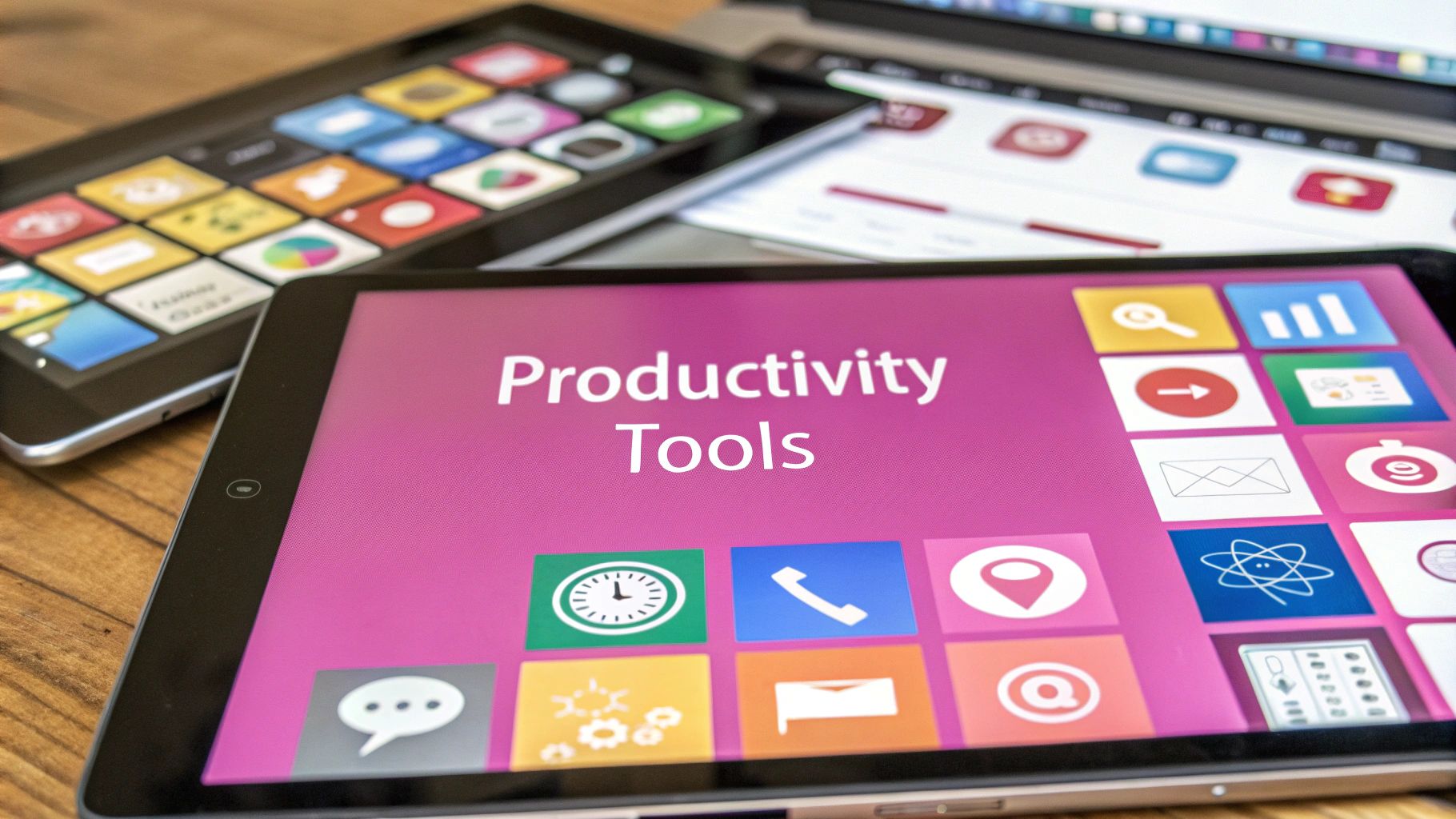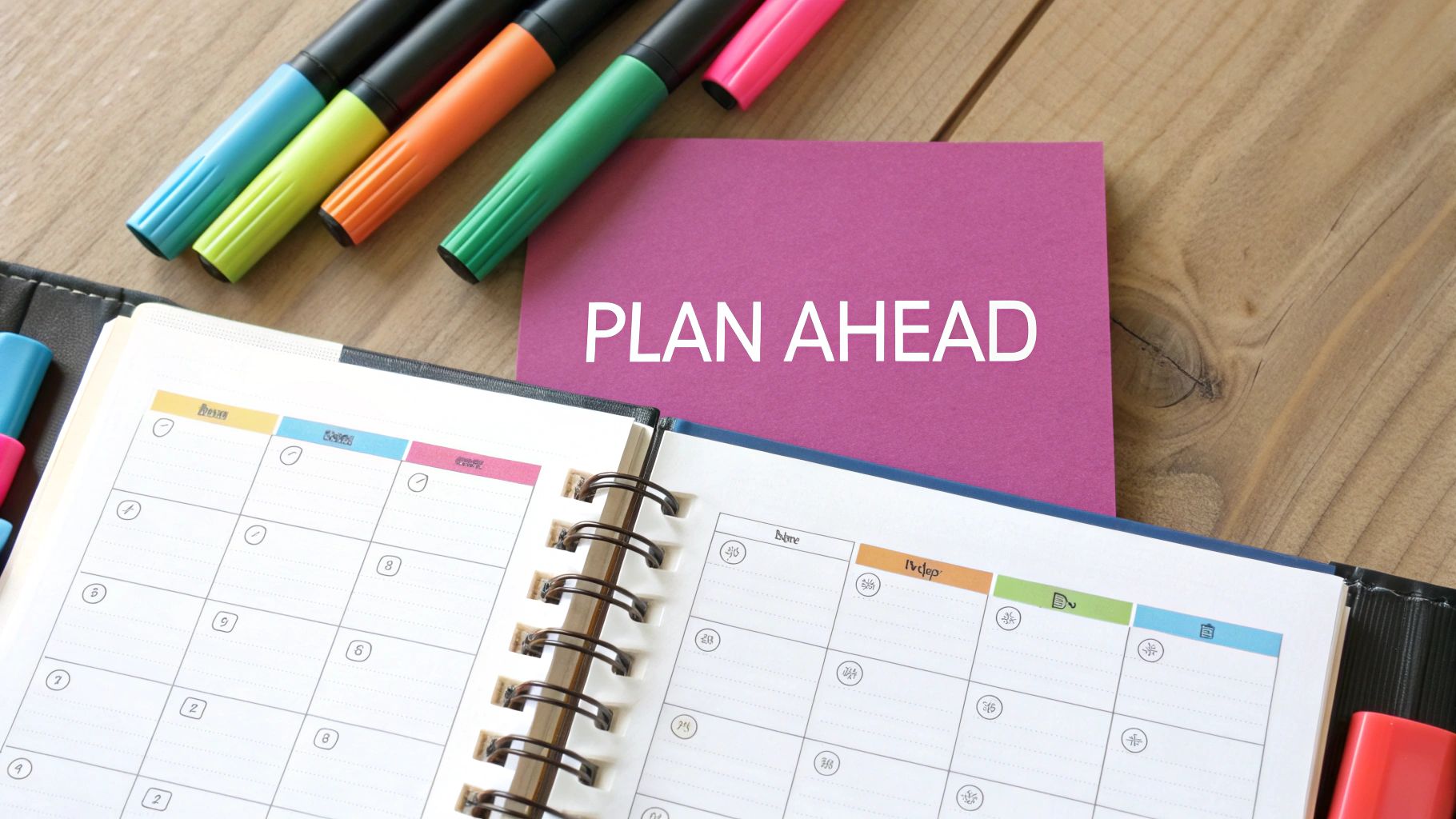
How to Study With ADHD: The Practical Guide for Better Academic Results
Understanding Your ADHD Brain for Better Learning

Common study approaches often miss the mark for people with ADHD because they don't align with how the ADHD brain actually works. While sitting quietly for hours might work well for some students, it can leave those with ADHD feeling frustrated and unable to focus. The good news is that by understanding your brain's natural patterns, you can develop study methods that work with your strengths rather than against them.
Recognizing Your Strengths
Living with ADHD comes with its own special abilities that can be powerful tools for learning. People with ADHD often show remarkable creativity, excel at solving complex problems, and can focus intensely on topics that spark their interest. Think of your brain like a sports car – it performs best when you give it the right conditions and fuel. Success comes from identifying these natural talents and finding ways to apply them to your studies.
Embracing Different Learning Styles
Finding the right study approach starts with understanding how your brain best processes information. Many ADHD students thrive when their learning involves movement, sound, or hands-on activities. This might mean walking while reviewing notes, playing background music during study sessions, or breaking large projects into smaller, more manageable pieces.
For example, if you learn better through visual aids, try making colorful mind maps or diagrams. If you remember things better when you hear them, record yourself explaining concepts or join a study group where you can discuss ideas out loud. For those who need movement, try reviewing flashcards while pacing or taking short exercise breaks between topics.
Creating a Supportive Study Environment
Your study space plays a key role in how well you can focus and learn. Both external distractions like noise and clutter and internal ones like racing thoughts can derail your concentration. Setting up a clean, well-organized study area and limiting notifications from devices can help you stay on task.
Managing internal distractions is just as important. Simple breathing exercises or brief meditation can help quiet a busy mind before studying. When you feel calmer and more centered, it's easier to absorb and retain information. Learning these techniques to handle both outside interruptions and inner restlessness helps create the focus you need for effective studying.
By getting to know how your ADHD brain works best, you can develop study methods that match your natural learning style. This understanding helps you create an environment and routine that support your success, leading to better academic results and less frustration along the way.
Creating Your Perfect Study Sanctuary
The right study environment makes a huge difference for students with ADHD. While a clean desk is important, effective studying with ADHD requires more – it's about designing a space that works with your brain rather than against it. Since everyone's needs are different, the ideal study setup looks unique for each person. So how can you create an environment that helps you study successfully with ADHD?
Taming the Physical Space
Your physical surroundings directly impact your ability to focus when studying with ADHD. Start with visual organization – a cluttered space often leads to a cluttered mind for those with ADHD. Keep your desk clear except for essential items, use storage solutions to contain supplies, and maintain general tidiness. This creates a clean mental slate for focusing on your work.
Lighting plays a key role too. Harsh overhead lights can be distracting, while dim lighting may make you drowsy. Try different options like natural sunlight, desk lamps, or even color-changing LED lights to find what helps you concentrate. Some students do well with a focused light on their workspace to minimize peripheral distractions.
Sound is another important factor to consider. Total quiet can actually make internal distractions more noticeable. But loud or unpredictable noises clearly disrupt focus. Test out different background sounds – white noise machines, nature recordings, or instrumental music – to discover what provides the right level of audio support. Many find that steady, gentle background sound helps block out both external disruptions and internal mental chatter.
Optimizing Your Digital Domain
With so much studying happening on screens now, managing your digital environment is just as crucial as your physical space. When studying with ADHD, start by turning off notifications on your devices. Those constant alerts can completely derail your concentration. Consider using website blocking tools or app timers to prevent access to distracting sites during study sessions. Think of these as friendly guardrails helping you stay on track.
Organizing digital files is equally important. Just like physical clutter, digital chaos makes it hard to find what you need and adds unnecessary stress. Create clear folder structures and consistent file naming conventions so materials are easy to locate. This simple digital organization saves time and mental energy you can put toward actual studying.
Tailoring Your Setup for Different Tasks
Different types of studying often need different environments. Deep focus work may require a quiet, minimal space with few distractions. But brainstorming or group projects might benefit from a livelier setting with some background activity and collaborative tools. Consider creating separate study zones for various tasks – perhaps a silent area for individual work and a more open space for group sessions. This flexibility lets you match your environment to your specific needs and goals. By thoughtfully adapting your space, you can transform studying with ADHD from a constant challenge into a more successful experience.
Mastering Time Without Fighting Your Brain

Most time management advice just doesn't click for students with ADHD. The usual approach of fixed schedules and completing tasks in order often feels impossible when your brain works differently. But there's good news – you can excel at managing time by working in harmony with your natural tendencies rather than against them. Success comes from understanding your individual strengths and developing flexible strategies that match how your mind operates.
Embracing the Power of Hyperfocus
For students with ADHD, hyperfocus can be an incredible asset when used effectively. This ability to deeply concentrate on tasks that capture your interest is a real strength. However, it needs careful management to avoid neglecting other important work. Here are practical ways to make hyperfocus work for you:
- Know Your Peak Hours: Pay attention to when you naturally feel most focused and energetic. Plan your challenging study sessions during these optimal times.
- Get Clear on Goals: Before starting work, specifically outline what you want to achieve. This helps prevent getting sidetracked into unrelated activities.
- Use Time Blocks: Try methods like the Pomodoro Technique – study intensely for 25 minutes, then take a 5-minute break. This helps channel hyperfocus productively while avoiding burnout.
Taming Procrastination with ADHD
While many students struggle with procrastination, ADHD can make it especially challenging. This usually stems from executive function differences that affect planning and starting tasks, not from lack of motivation. The good news is you can develop effective strategies to overcome procrastination:
- Make Big Tasks Smaller: Break large projects into clear, manageable pieces. This prevents feeling overwhelmed and gives you wins to celebrate along the way.
- Do a Brain Download: Get every task out of your head and onto paper, no matter how minor. This frees up mental space and helps you see what needs doing.
- Start Small: Begin with something quick and simple to build momentum. Getting that first task done often makes it easier to tackle bigger challenges.
Building Sustainable Study Routines
While strict schedules may not suit your style, creating flexible routines can provide helpful structure. Focus on developing consistent habits that work with your natural learning patterns rather than forcing yourself into a rigid system:
- Create Study Zones: Set up different areas for different types of work. You might have a quiet spot for focused study, an active space for reviewing notes, and a social area for group projects.
- Include Movement: Many students with ADHD think better when moving. Take exercise breaks, walk while listening to lectures, or try a standing desk setup.
- Focus on Basics: Good sleep and nutrition make a big difference in concentration and learning. Aim for 7-9 hours of sleep nightly and include brain-friendly foods like fruits, vegetables and healthy fats in your diet.
Success with time management comes from understanding and working with your brain's unique patterns. When you embrace your natural tendencies – like hyperfocus – while actively managing challenges through practical strategies and supportive routines, you create a foundation for academic achievement that feels sustainable and authentic to you.
Making Information Stick: Memory Techniques That Work

For students with ADHD, finding effective memory techniques is key to academic success. While standard memorization methods often fall short, there are several proven approaches that work well with how the ADHD brain processes and retains information. By using techniques that tap into your brain's natural strengths, you can make learning feel less like a chore and more like an engaging activity that sticks.
Multi-Sensory Learning: Engaging Your Whole Brain
When you involve multiple senses in learning, your brain creates stronger memory connections. Rather than just reading silently, try reading out loud while highlighting important points in your textbook. You can also add movement to your study routine – walk around while reciting facts or use hand gestures to represent key concepts. Each additional sense you engage creates a new pathway for remembering the information, similar to creating multiple roads leading to the same destination in your mind.
Active Recall: Testing Yourself for Better Retention
Instead of re-reading your notes over and over, test yourself on the material to cement it in your memory. Use flashcards, quiz yourself, or explain concepts to a friend or family member. After reading a textbook chapter, close the book and write down everything you remember. This process of actively retrieving information strengthens your brain's ability to recall it later, especially during tests when it matters most.
Personalized Note-Taking: Making Information Your Own
Creating your own note-taking system is essential for processing information in a way that makes sense to you. Try using mind maps to connect related ideas, color-code different topics, or draw simple diagrams to explain complex concepts. If you're someone who thinks in pictures, sketching out concepts may help you understand and remember them better than writing traditional notes. The goal is to transform passive note-taking into active learning that fits your personal style.
Turning "Boring" into Engaging: Practical Tips for Any Subject
Even the driest subjects can become more memorable with creative approaches. Connect facts to personal stories, use humor to make concepts stick, or link new information to topics you already enjoy. For example, if history dates seem meaningless, create memorable rhymes or connect them to events in your own life. Break large chunks of information into smaller, digestible pieces that are easier to process. Take regular breaks to keep your mind fresh, and remember that finding your own way to connect with the material is more important than following conventional study methods. When you adapt study techniques to work with your brain instead of against it, you'll likely see better results and actually enjoy the learning process more.
Making Technology Work for Your ADHD Study Sessions
For students with ADHD, technology presents both opportunities and challenges. While digital tools can support learning in powerful ways, they can also become major distractions. Success comes from picking the right tools and using them with purpose. Let's explore specific strategies that help students with ADHD use technology to study more effectively.
Selecting ADHD-Friendly Study Tools
The best study apps for ADHD students have features that directly support focus, organization and learning. When choosing tools, look for:
- Focus Support Features: Tools like timers, website blockers, and background noise generators help create a distraction-free study environment. The Forest app makes staying focused fun – you grow a virtual tree while working, but if you leave the app early, your tree dies.
- Organization Tools: Apps with built-in calendars, task lists, and note-taking features help track assignments and deadlines. Trello and Asana let you organize tasks visually.
- Multi-Sensory Learning: Some apps engage different learning styles through audio playback, visual organizers, and interactive practice. Quizlet and Anki are great for creating flashcards and active recall exercises.
Creating Structure with Tech Tools
Technology can help students with ADHD establish and maintain productive study routines. The Pomodoro Technique, which breaks work into focused intervals with short breaks, works well for many ADHD students. Apps like Focus To-Do combine a Pomodoro timer with task management.
Digital calendars and reminders also help by providing external structure and reducing mental load. Google Calendar and Microsoft Outlook are reliable options for scheduling study sessions and tracking deadlines.
Managing Digital Distractions
The same devices meant for studying can quickly become sources of distraction. Social media, games, and web browsing can derail focus in seconds. Website blockers like Freedom and Cold Turkey help by restricting access to distracting sites during study time.
Creating a separate study profile on your computer or tablet also helps. This creates clear boundaries between study and leisure time, making it easier to stay focused on schoolwork.
Learning Through Multiple Senses: The Notescast Example
Notescast shows how technology can support different learning styles by turning notes into engaging videos. For ADHD students who struggle with traditional reading, combining audio and visual elements often improves understanding and retention. This matters because about 15% of college students report having ADHD, according to a 2022 study. By thoughtfully choosing and using tech tools, students can create study environments that work with their ADHD rather than against it.
Building Long-Term Academic Success Habits

Academic success with ADHD requires more than quick fixes – it demands building lasting habits that work over time. The key is developing strategies for resilience, staying motivated, and effectively communicating your needs throughout your education.
Cultivating Resilience and Maintaining Motivation
Students with ADHD need strong resilience to handle academic challenges. When you face setbacks, having specific coping tools makes a big difference. Try breaking complex assignments into smaller tasks you can tackle one at a time. Take a moment to celebrate completing each part. When a subject feels overwhelming, see it as a chance to try new study methods rather than viewing it as failure. Connect your current coursework to your future goals to stay focused when things get tough.
Advocating for Your Needs
Clear communication about your learning needs is essential for success. Take time to understand how you learn best and what support helps most. Have open conversations with your professors and academic support staff about specific challenges you face. For example, if you focus better with extra test time or a quiet study space, request those accommodations directly. Speaking up shows you're taking charge of your learning.
Identifying Early Warning Signs and Implementing Intervention Strategies
Learn to spot signs that you're starting to struggle, like missing multiple deadlines or feeling constantly behind. When you notice these patterns, take action quickly. Meet with a tutor, adjust your study schedule, or review your organization system. Think of it like checking your GPS – making small course corrections prevents getting far off track.
Building Support Networks and Maximizing Campus Resources
Having people to turn to makes managing ADHD in college much easier. Connect with classmates facing similar challenges. Join study groups where you can share strategies. Many schools offer specialized ADHD support through time management workshops, study skills training, and helpful technology. These resources provide guidance while connecting you with others who understand your experience.
Planning for Future Academic Goals
While managing daily coursework is important, keep your bigger goals in view. Look for ways your current classes connect to your career interests. Seek out hands-on experience through research projects, internships, or relevant clubs. Having clear long-term direction helps maintain focus through the daily challenges of studying with ADHD.
By building these foundational habits, you develop both the academic skills and personal resilience needed for ongoing success in school and beyond.
Ready to transform your notes into engaging videos that make studying easier and more effective? Check out Notescast and experience a new way to learn.
